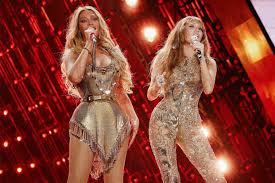The city of lights shimmered just a little brighter on June 21 as Beyoncé Knowles-Carter, global icon and musical revolutionary, returned to the Stade de France for her second sold-out show in Paris as part of her “Cowboy Carter and the Rodeo Chitlin’ Circuit Tour.” The evening was nothing short of extraordinary—blending fashion, culture, family, and raw talent into a glittering showcase of artistic mastery.
From heartfelt speeches to surprise guest appearances, from couture fashion statements to poignant cultural tributes, Beyoncé once again reminded the world why, three decades into her career, she remains a force like no other.
The concert began at approximately 8:36 p.m. local time, but anticipation had been building for hours outside the stadium gates. Inside, the energy was electric even before the queen hit the stage. And when she finally did, Beyoncé didn’t just sing—she spoke directly to the thousands who filled the massive venue.
“Y’all are absolutely stunning. Thank you guys for having us tonight. Thank y’all for being here tonight. I’m so thankful for your loyalty for almost 30 years,” she told the crowd.
The words landed with the kind of emotional weight only she could deliver. Beyoncé’s 30-year reign hasn’t been without challenges, but it’s been built on consistency, talent, innovation, and a fierce bond with her fans. From her early Destiny’s Child days to solo superstardom, from pop to R&B to country and beyond, Beyoncé’s evolution mirrors the changing tides of music and society itself.
This tour, and especially this stop in Paris, feels like a culmination of that journey.
If the show’s beginning was powerful, what came next was euphoric.
Halfway through the performance, the audience collectively lost its breath as none other than Miley Cyrus emerged onstage. The two Grammy-winning stars joined forces to perform their tender duet, “II Most Wanted,” sending the crowd into a frenzy. Clad in matching gold ensembles, the moment was more than just visually stunning—it was deeply symbolic.
As they held hands and sang together, the connection between the two artists was palpable. The duet—already beloved by fans—took on a new life, elevated by the live setting and mutual admiration between the performers. It was a celebration of sisterhood, artistry, and shared respect between two women who have each carved distinct and fearless paths through the music industry.
No Beyoncé concert would be complete without show-stopping fashion, and in the world’s fashion capital, she certainly delivered.
From the opening number, Beyoncé made a visual statement. She appeared in a brilliant white outfit complete with a custom cowboy hat, immediately tying together the “Cowboy Carter” theme with Parisian flair. This wasn’t your average Western wear—this was haute couture meets Southern soul.
But that was only the beginning. Throughout the night, Beyoncé cycled through a range of new looks, each more eye-catching than the last. One fan excitedly noted online: “New outfit for ‘Alligator Tears,’ ‘Just for Fun,’ ‘Protector,’ and ‘Flamenco’ — Beyoncé looks incredible!”
The commitment to fashion was unmistakable. Every look was purposeful, crafted to reflect the emotion and theme of the song she was performing. Whether it was a glimmering flamenco-style gown or an ethereal protector-inspired ensemble, Beyoncé used fashion not just as a costume, but as a narrative device.
Notably in attendance was legendary French designer Christian Louboutin, whose red-soled shoes have graced countless red carpets and stages—including Beyoncé’s own. His presence added another layer of glamour and credibility to an already unforgettable night.
Just when fans thought the surprises had ended, Beyoncé introduced yet another layer of artistry to her show. This time, it came in the form of movement.
“We have a special guest tonight. Please give it up for The Mayyas,” she announced to a roaring crowd.
The Mayyas, an all-female Lebanese dance troupe led by choreographer Nadim Cherfan, brought a hypnotic energy to the stage during the song “Protector.” Their flowing movements, intricate formations, and visual storytelling provided a mesmerizing complement to Beyoncé’s vocals.
The collaboration was not a one-off. The Mayyas previously worked with Beyoncé, and their reunion was met with joy by fans who praised the pairing for its elegance and global significance. In a world where dance often plays second fiddle to music, Beyoncé continues to elevate it as a central form of expression—especially when it intersects with culture, identity, and empowerment.
Beyoncé’s “Cowboy Carter” tour is more than a series of concerts—it’s a cultural movement.
Launched in Los Angeles on April 28, the tour’s concept is rooted in Beyoncé’s desire to reclaim and reinterpret country music, a genre with Black origins that has been historically whitewashed. The tour’s name itself, “The Rodeo Chitlin’ Circuit,” nods to the network of venues where Black musicians once performed during segregation—a bold declaration of heritage and rebellion.
By incorporating country, gospel, soul, and even spoken-word elements into her live performances, Beyoncé isn’t just entertaining—she’s educating and provoking thought. Songs like “Protector” and “Alligator Tears” are steeped in generational trauma, motherhood, and resilience, offering deeply personal reflections beneath their melodic surfaces.
And her decision to launch the Paris leg of her tour on Juneteenth was no coincidence. The holiday, which commemorates the emancipation of enslaved African Americans, served as a powerful backdrop for the themes Beyoncé explores throughout her new musical era. Parisian fans reportedly organized a visual tribute to mark the occasion, holding up signs and waving symbolic flags, turning the event into a cross-cultural celebration of Black freedom and excellence.
The Paris shows include a sprawling 39-song setlist that pulls from every era of Beyoncé’s career. From early fan favorites to new anthems from the “Cowboy Carter” album, the selection is both a retrospective and a revolution.
Some of the standout numbers include:
- “Flamenco” – paired with a fiery red gown and dramatic lighting
- “Alligator Tears” – where vulnerability meets powerhouse vocals
- “Protector” – performed with The Mayyas for a visual and emotional crescendo
- “II Most Wanted” – the Cyrus duet that left fans speechless
Yet, even beyond the setlist, it’s the fluidity of the show that impresses most. Songs aren’t simply performed—they’re staged, choreographed, and directed like pieces of theater. Costume changes, lighting transitions, and thematic interludes make each number feel like a standalone story.
Despite the grandeur, Beyoncé’s message in Paris was deeply intimate. Her words to the crowd, her nostalgic song choices, and her graciousness toward collaborators all point to an artist in full command of her identity. After nearly three decades, she has nothing left to prove—but everything left to share.
Her performance was a love letter to her fans, thanking them for the journey. But it was also a love letter to herself. This era of Beyoncé is one of reflection, reclamation, and reaffirmation. She is honoring her roots while expanding her wings, paying tribute to her ancestors while preparing a legacy for her children.
As the world turns its eyes to her third and final Paris show on June 22, the question on everyone’s mind is: what’s next?
If Beyoncé has taught us anything, it’s that no two shows are ever the same. Whether it’s another surprise guest, a debut song, or an unexpected tribute, the final night in Paris is sure to leave a lasting mark—not just on those in attendance, but on the cultural moment as a whole.
For now, the thousands who witnessed her June 21 performance are still basking in the afterglow of an artist at the peak of her powers, fearless and free.
Beyoncé’s second show in Paris was not just entertainment. It was history, art, culture, and emotion fused into a singular, transcendent event. Through music, fashion, movement, and message, she invited the world to remember where we’ve been—and imagine where we’re going.
In gold gowns, glowing lights, and grace, Beyoncé turned a stadium into a sanctuary and reminded us that the rodeo, the rebellion, and the reinvention are far from over.



